Complex compositions
What you should pay special attention to
A plasticine painting is a real little masterpiece that requires more attention, patience and the ability to mix colors with each other.
Never invite your child to start with complex compositions, which most likely will not work out the first time, which will cause reluctance to work with plasticine in the future.
If your child loves to sculpt and is already making simple images on his own, encourage him to create a more complex pattern.
Made with small flat strokes, the applique from a distance resembles oil painting. There is an important rule here: the strokes applied with your fingers should be small and even so that the finished work looks finished and neat.
The applique pattern can be convex, its elements will protrude above the surface. This work can also be enclosed under glass by first placing a border along the edges between the glass surfaces.
Didactic games for the development of sensory and fine motor skills of the hands
Didactic game “Magic Book” for the development of sensory and fine motor skills.
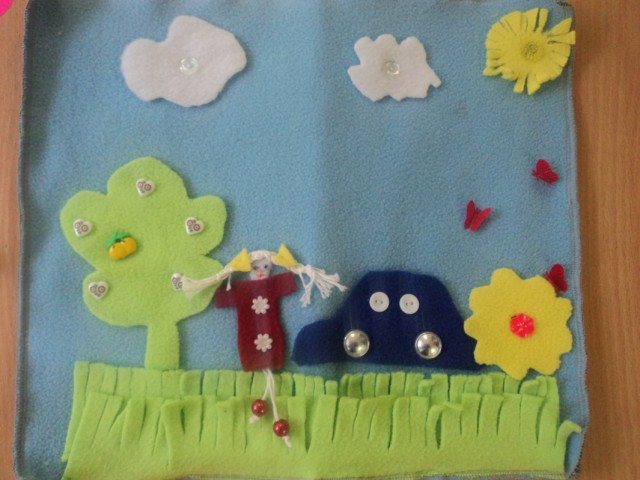
I work as a teacher in 1ml. group. In my work I use the “Magic Book” manual. The manual consists of several sheets of 26x30 cm sewn fabric, fastened with Velcro. Each sheet has an applique sewn onto it (there are laces, ribbons, buttons, Velcro, etc., illustrating a particular plot. All sheets can be detached and distributed to children. This makes it possible to organize independent activities for the entire group at once. This game allows you to solve many problems:
- cultivate cognitive interest, perseverance
-develop the ability to examine objects, highlighting their color and shape (unfasten buttons, tear off Velcro items, circle objects, etc.)
-develop fine motor skills, visual perception, attention, memory, coherent speech.
- consolidate knowledge about color.
Children really like this game.
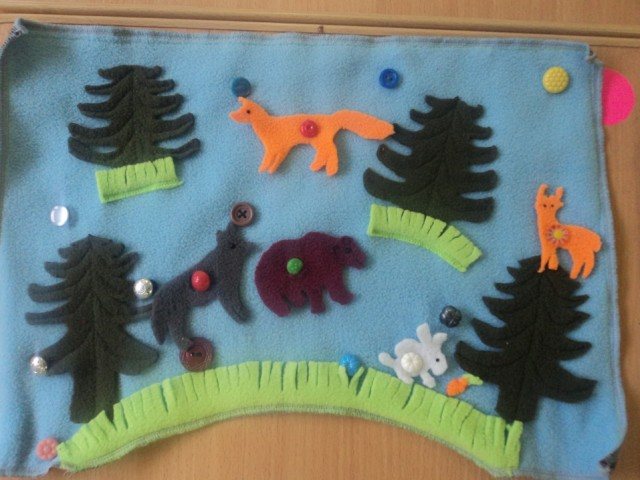
Purpose: Develops the child's thinking, fine motor skills and tactile perception. It has been proven that children who have such toys at their disposal demonstrate better imaginative thinking, memory, and logic. Such children will be more collected and attentive in the future. What is interesting: in this case, development takes place in a relaxed atmosphere (during independent play or in the process of creative, interesting and free play with adults).
Didactic game “Complete the picture using a button”
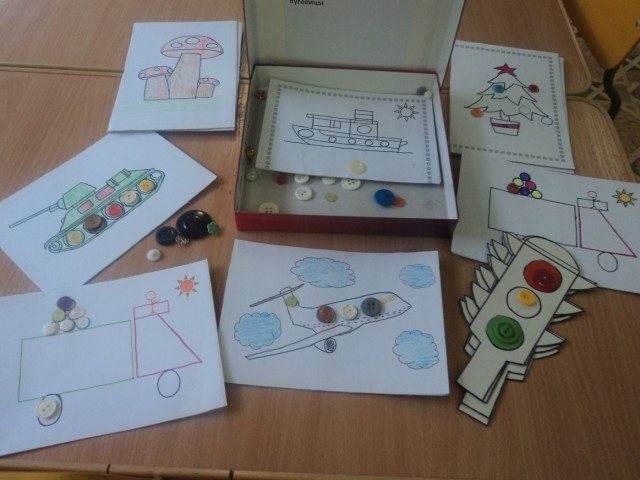
Means: illustrations depicting flowers, airplanes, fly agarics, etc., buttons.
Goal: to develop children's imagination and creativity.
Properties of the object: size (large, small), shape (circle), color; developing the ability to alternate objects by color and size.
Didactic game “Find the extra traffic jam”
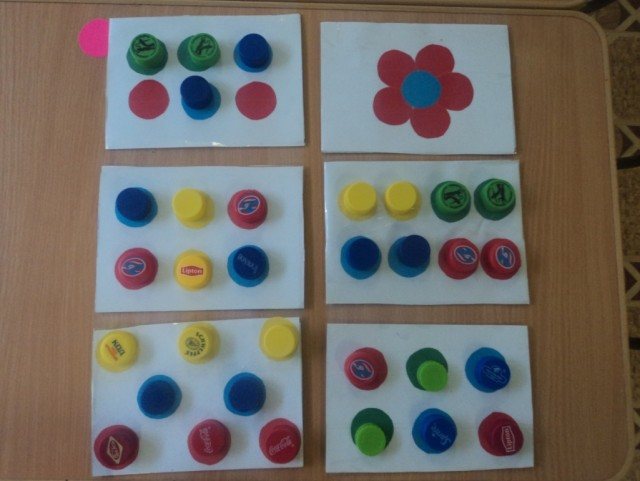
Means: corks of different colors and sizes.
Goal: development of logical thinking.
- Consciousness of an emotionally positive mood.
- Development of interest and motivation to action.
- Introducing sensory standards: getting to know different
- Properties of an object: size (large, small), shape (circle), color; developing the ability to alternate objects by color and size.
- Development of the motorized hand: developing the ability to perform actions with objects.
- Forming the skill of jointly completing a task: developing cultural communication skills;
- Development of the ability to understand and correctly perform tasks;
- Formation and activation of the child’s vocabulary: development of the ability to look at a picture, name the objects depicted on it, their qualities and actions;
- Development of perception: visual, tactile.
- Development of visual – effective, imaginative thinking, attention, memory, imagination.
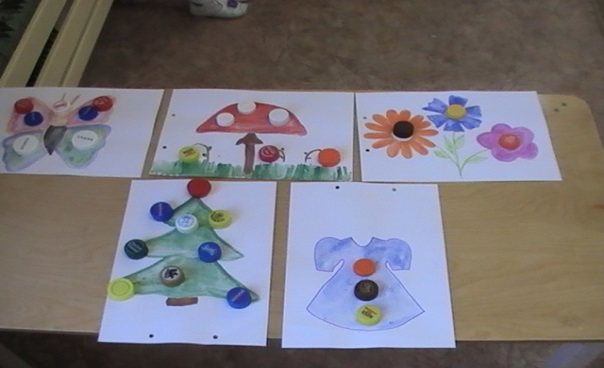
Educational game for developing fine motor skills “Feed the piglet” with your own hands
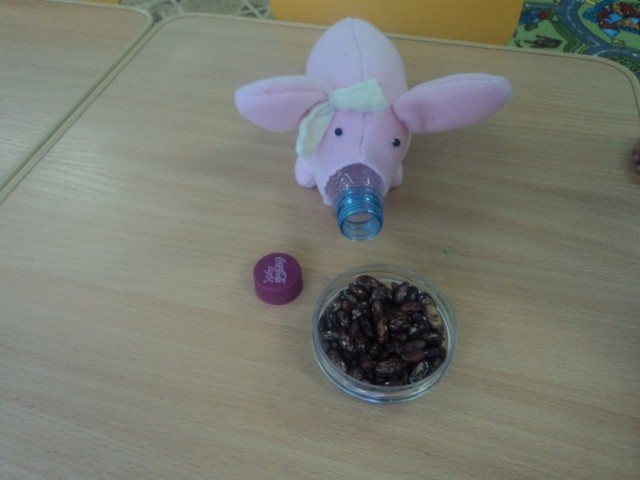
Remedy: a soft toy (pig) and a bottle the size of the soft toy. Get mixed feed - beans, peas, corn flakes, etc.
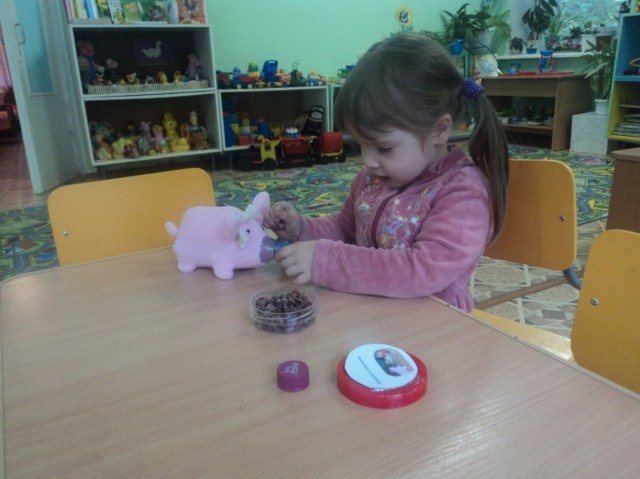
When the little pig has had lunch, screw her up until dinner))
Shake the pig - the food inside rattles pleasantly, which means the pig is full and happy!
Author: Lilit Avetisyan
Universal materials for creativity
Modeling can be safely classified as one of the types of fine art, which brings undoubted benefits in the process of growing up a child as an individual.
Modeling clay is a mixture of natural products: salt, flour and water. The recipe is simple and does not require large material costs. Well-kneaded dough is plastic and pleasant to the touch, easily deformed. But in the open air it hardens and becomes brittle. Store in the refrigerator in a plastic bag for no more than 4-5 days.
Plasticine is crushed and purified clay powder with the addition of wax, fat, petroleum jelly, and ozokerite. It can take any shape and is pleasant to the touch, so kids love to roll it in their hands. To increase softness, it is recommended to warm it in your palms.
Children, by performing various crafts, learn to fantasize, develop intellectual abilities, and begin to realize beauty and harmony. It is at this time that purity, perseverance, hard work and determination are laid.
Didactic games for children of the first junior group
Didactic games for children 2-3 years old
Didactic game “Pass the Eggs”
This game is for developing motor skills. It is for children 2-3 years old. To make it you will need: a wooden stand, 2 plastic bottles (the bottom of which is round), a spoon and Kinder Surprise eggs. Cut off the top part of the bottle so that children do not get hurt, melt the edge with matches. Attach the bottles to the base using self-tapping screws. Bend the spoon at an angle of 90 degrees. The game is ready. Task: without using your hands, use a spoon to transfer eggs from one jar to another.
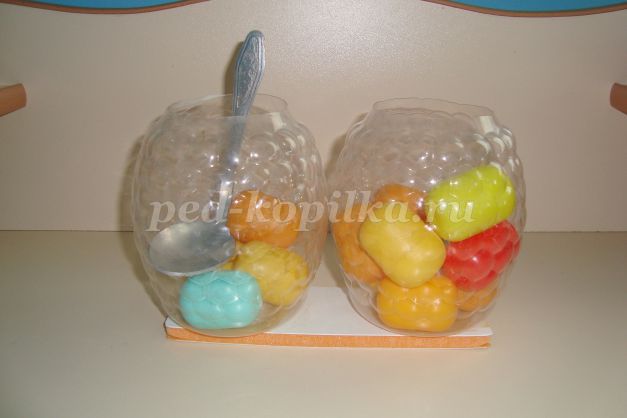
And with these spoons we play another game, “Who can catch the most eggs.” A basin of water, buckets (1 per child) and Kinder Surprise eggs. Task: catch an egg with a spoon and put it in a bucket.
Didactic game "Lids"
This game is for developing fine motor skills. For children 2-3 years old. The development of fine motor skills in a child’s hands is important not only for speech development, but also for the overall development of the child. Fine motor skills are the ability to make small movements with your fingers. With age, movements become more complex and more varied. Material: plastic bottles, box, self-adhesive colored paper, multi-colored laces. Choose a sturdy box of the size you need. Cut the top of the bottle (neck) to a height equal to the height of the box. Make holes in the box for the necks of the bottles so that they are screwed in rather than just pushed in, this will make the connection stronger. Select bright lids, make holes in the lids with a hot awl, thread a string, and secure with a knot. Pass the string through the box and, on the other side, attach the second lid in the same way. The number of necks and lids depends on the size of the box and your desire. Cover the box with colored self-adhesive paper. Use bright, rich colors. The game is ready.

Didactic game "Beads"
A game for developing fine motor skills. For children 2-3 years old. In our kindergarten we had a lot of old rings from pyramids. I collected them in a bright box and put colorful laces. To prevent the rings from falling off, I tied a large knot on one side of the lace. At first, children learned to simply string rings onto a string. Then the tasks became more complicated, alternating by color and size. This is the kind of game made from old parts.
We recommend watching:
Didactic manual for the younger group “Fishing” Educational design game for children 3 years old Do-it-yourself flannelgraph Didactic game for children 2-3 years old
Similar articles:
Didactic math game for younger preschoolers
Didactic game for children of primary preschool age with developmental problems
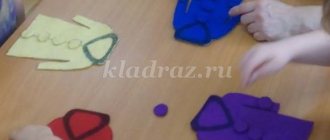


![Literacy lesson in the preparatory group “Sounds [K[-[K'] and the letter K”](https://properbooks.ru/wp-content/uploads/zanyatie-po-obuchenii-gramote-v-podgotovitelnoj-gruppe-zvuki-k-k-330x140.jpg)